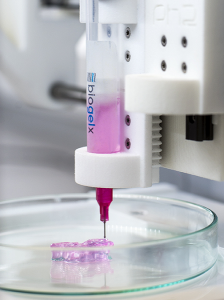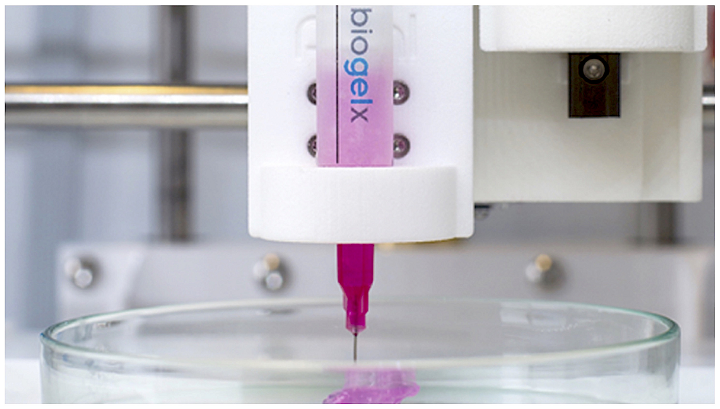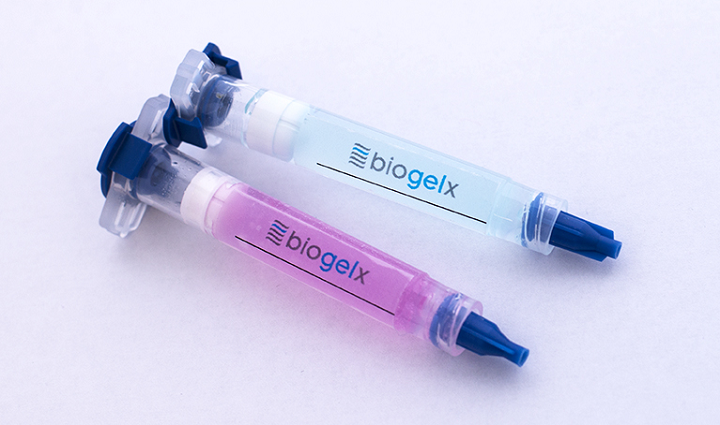In 2013, a company called Biogelx was spun out from the University of Strathclyde in Glasgow, Scotland for the purposes of developing tunable, synthetic materials for use in 3D cell cultures and 3D bioprinting applications. Early on, the company worked on creating 3D cell culture scaffolds, which were in the form of synthetic peptide hydrogels so as to support cell growth by behaving as an extracellular matrix environment.
Bioinks are loaded up with cells in order to 3D print biological structures. Then, once the structure is printed, secondary crosslinking mechanisms help retain the shape’s structural fidelity. These bioprinting materials can facilitate cell adhesion, differentiation, and proliferation, as well as exhibit all the characteristics of an extracellular matrix environment. This is what makes it possible to create patient-specific human tissues in a laboratory setting, which is why good bioinks are very important.
 Biogelx’s hydrogel bioinks have unique physical and chemical tunability, which means they can successfully replicate specific tissue characteristics so cells can engage with, and experience, a 3D environment that’s pretty close to real life. Early on, the industry recognized how beneficial Biogelx’s hydrogel bioinks could be for researchers in the industry, as the materials claim to offer reproducibility, great printability, an easy crosslinking method, and viscosity control in one package. The company’s bioinks can provide a base modular material where the cells’ chemical and mechanical properties are able to be adapted.
Biogelx’s hydrogel bioinks have unique physical and chemical tunability, which means they can successfully replicate specific tissue characteristics so cells can engage with, and experience, a 3D environment that’s pretty close to real life. Early on, the industry recognized how beneficial Biogelx’s hydrogel bioinks could be for researchers in the industry, as the materials claim to offer reproducibility, great printability, an easy crosslinking method, and viscosity control in one package. The company’s bioinks can provide a base modular material where the cells’ chemical and mechanical properties are able to be adapted.
That’s why Biogelx is proud to launch its first product range of novel, synthetic bioinks: Biogelx-INKS. As the company says on its website, the future is synthetic.
“We are excited to announce the commercial availability of Biogelx
-INKs,” said Biogelx CEO, Mitch Scanlan. “Providing versatility and improving research outcomes are the key focuses for our product portfolio. We look forward to supporting researchers in their mission to develop realistic 3D disease modules, tissues, and organs for future pharmaceutical and medical applications.”
Developed with 3D printability at the forefront, Biogelx-INKs have been optimized for use in extrusion 3D printers, and they’re also versatile enough to work in 3D printing applications other than just bioprinting. The bioinks maintain the company’s core self-assembling peptide technology, and just like Biogelx’s hydrogel products, these new Biogelx-INKs form a nanofibrous network in order to mimic an extracellular matrix environment. This supports cell growth, proliferation, and signaling, but in addition, Biogelx-INKs were developed in such a way as to, as the company put it, “ensure the rheological properties are suitable for bioprinting applications.”
 According to the Biogelx website, its new bioinks can be printed with good 3D fidelity, and don’t require any support, sacrificial, or curing inks. Biogelx-INKs also offer important shear-thinning behavior, which helps with cell viability, and controllable gelation, which is triggered by adding cell culture media and does not require the addition of reactive crosslinking reagents, UV curing, adjustments in pH, or extreme temperature. This feature also makes the material compatible with many different 3D bioprinters.
According to the Biogelx website, its new bioinks can be printed with good 3D fidelity, and don’t require any support, sacrificial, or curing inks. Biogelx-INKs also offer important shear-thinning behavior, which helps with cell viability, and controllable gelation, which is triggered by adding cell culture media and does not require the addition of reactive crosslinking reagents, UV curing, adjustments in pH, or extreme temperature. This feature also makes the material compatible with many different 3D bioprinters.
The company’s technology is based on a system of two peptides – a hydrophobic ‘gelator’ peptide (Fmoc-diphenylalanine) and a hydrophilic ‘surfactant’ (Fmoc-serine) – which self-assemble to form fibers in aqueous environments. These fibers have surface hydrophilic functionality, which is appropriate for cell adhesion.
Additional features of Biogelx-INKs include:
- Reproducible – these bioinks are totally synthetic and manufactured under strict quality control, which ensures batch-to-batch reproducibility and consistent prints.
- Tuneable – it’s possible to tailor the biomimetic functionality of the bioinks to specific cell types.
- Biocompatibility – composed of amino-acids, Biogelx-INKs are >95% water and produce a nanoscale structure which mimics the natural extracellular matrix environment.
- Material Biomimicry – this product range includes formulations that incorporate several biomimetic peptide sequences, which increases its biocompatibility with various cell types.
According to the Bioglex website, “With our core technology, our bioinks can be tailored to specific applications, meaning they have huge potential in a range of fields including cell research, toxicology, drug screening, and regenerative medicine.”
If you’re interested in the company’s new range of Biogelx-INKs, you can order the product, in one of three sizes, for £280.
Discuss this story and other 3D printing topics at 3DPrintBoard.com or share your thoughts in the Facebook comments below.
[Images: Biogelx]



21 Replies to “Biogelx Launching First Product Range of Synthetic Bioinks for Variety of 3D Printing Applications”
Comments are closed.